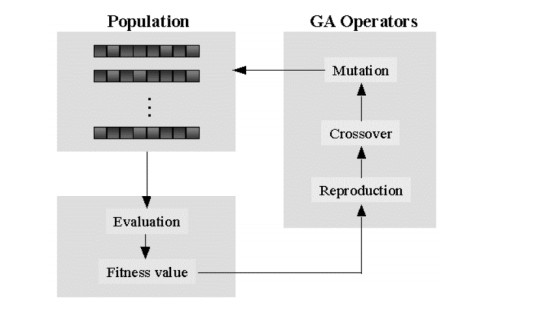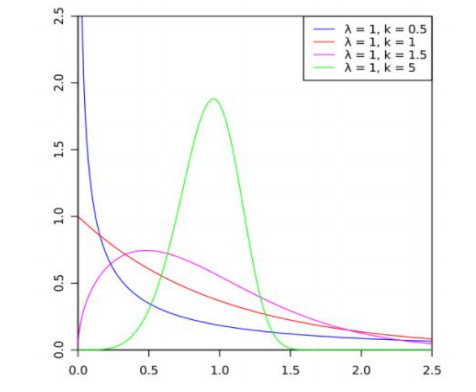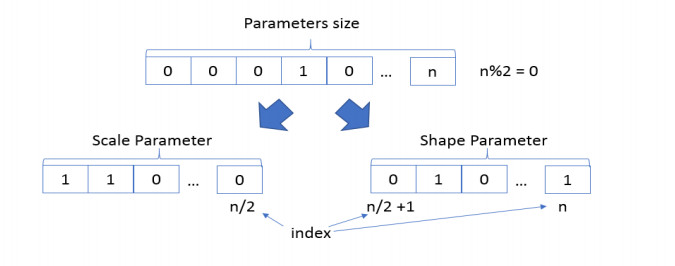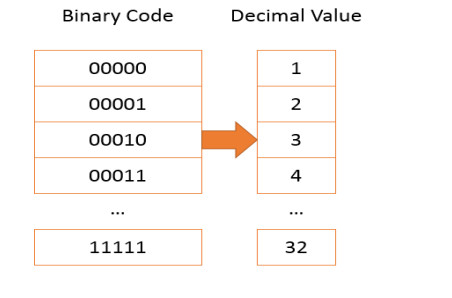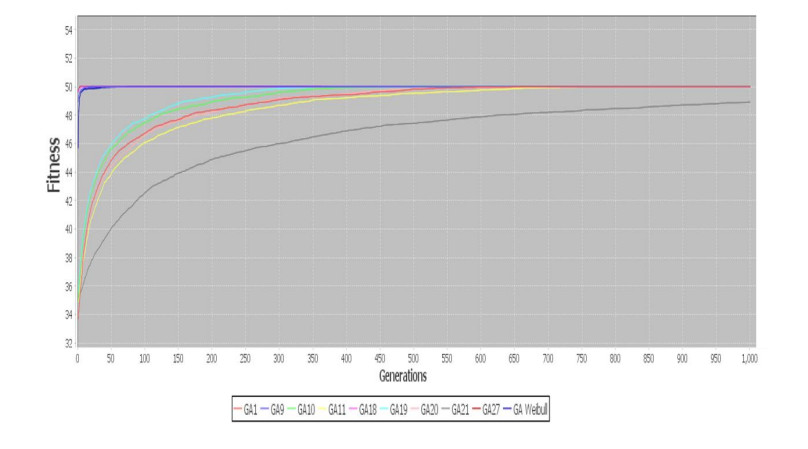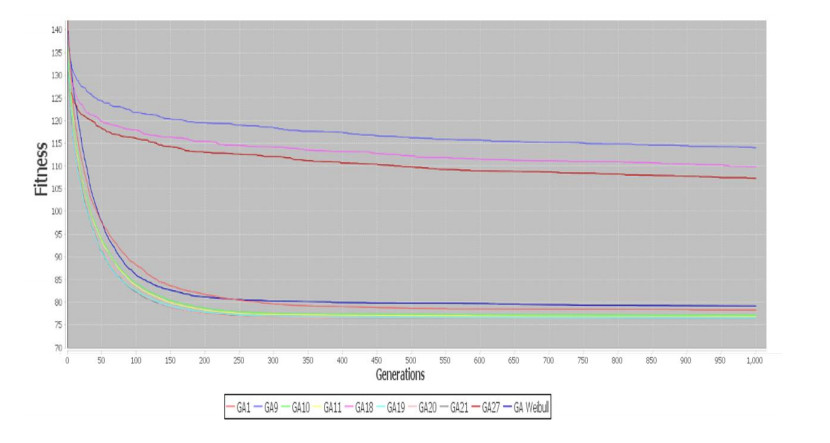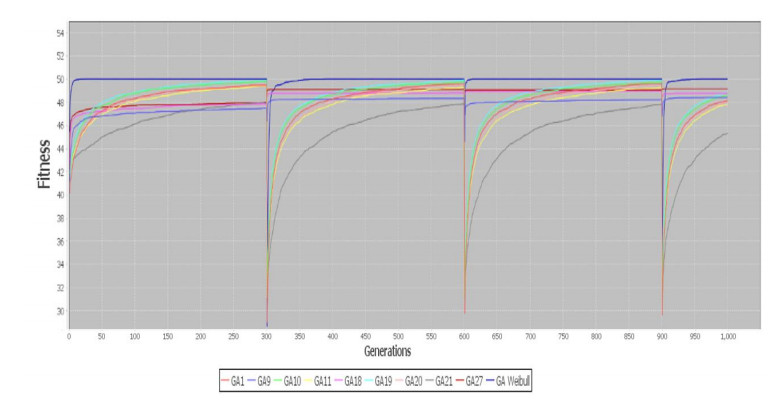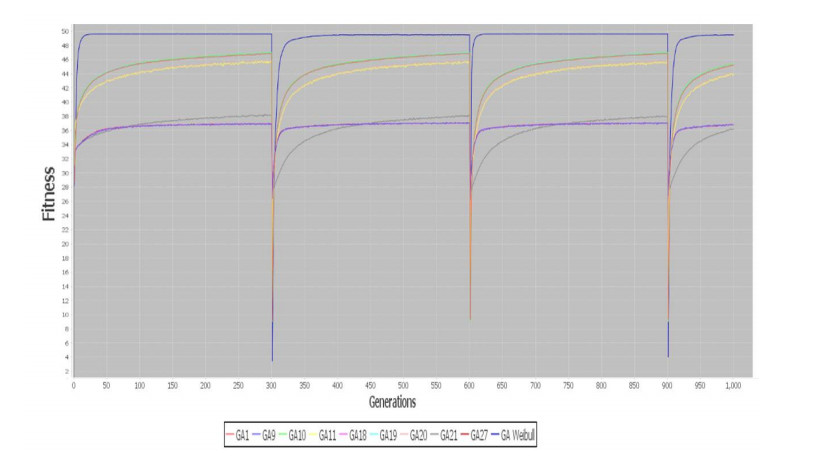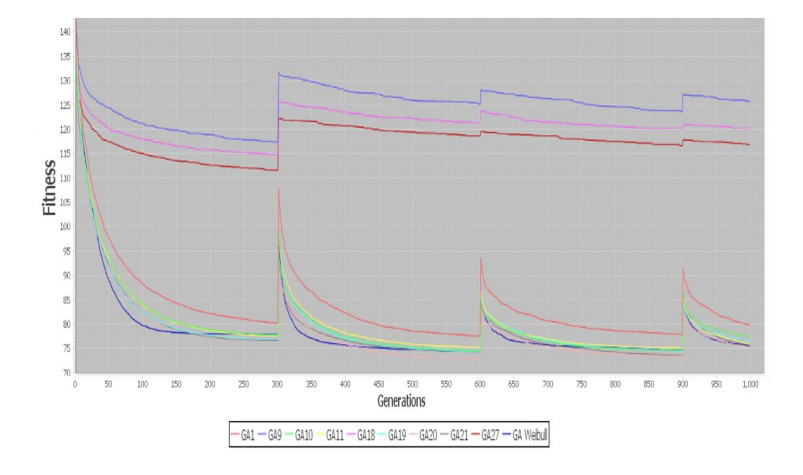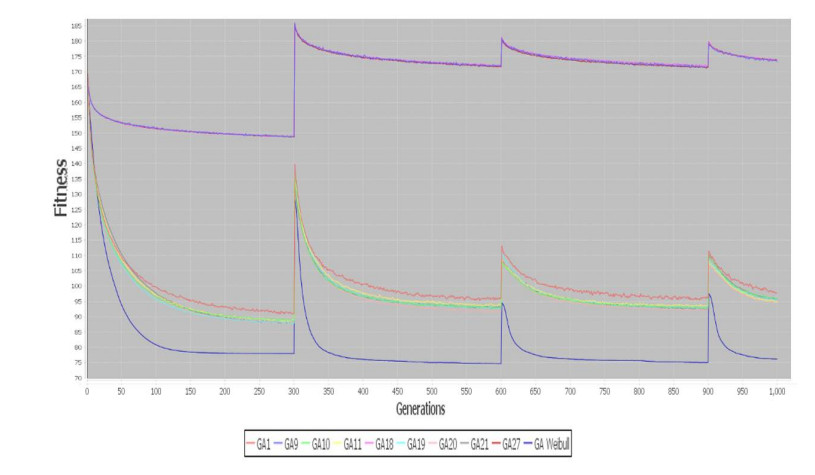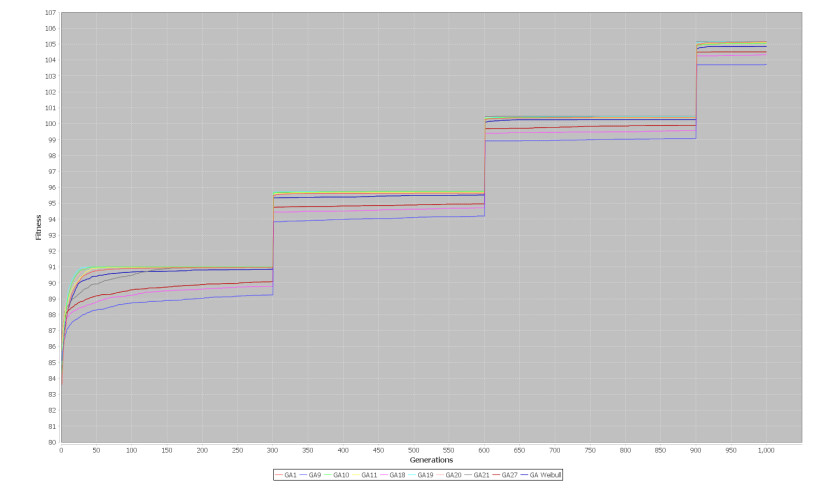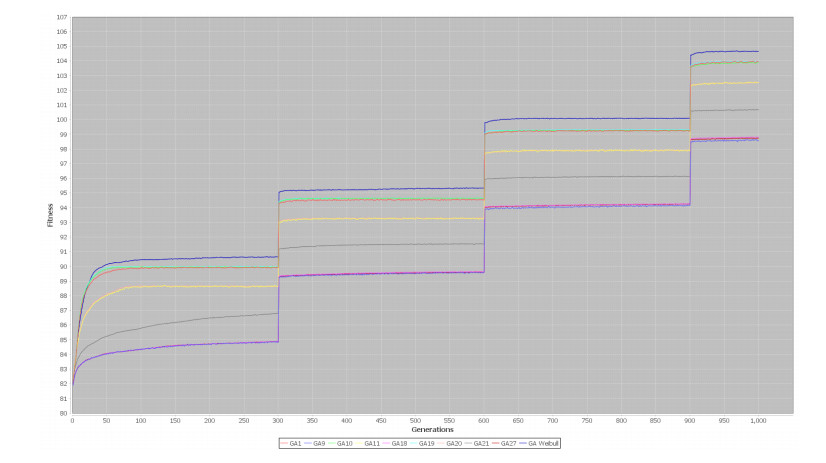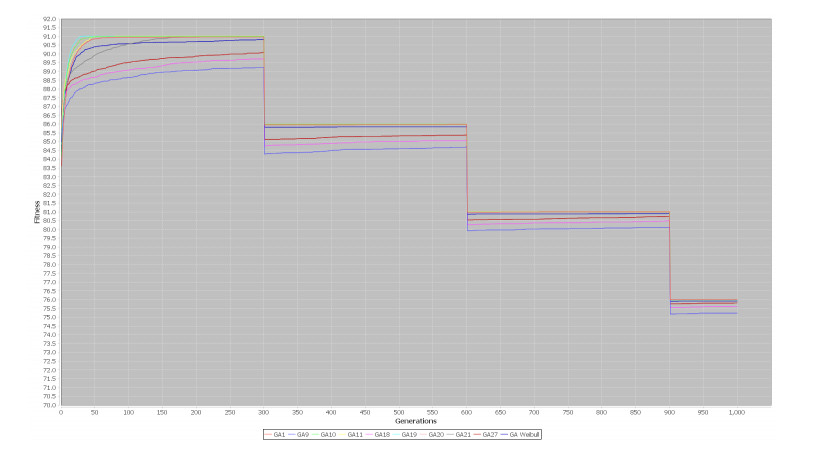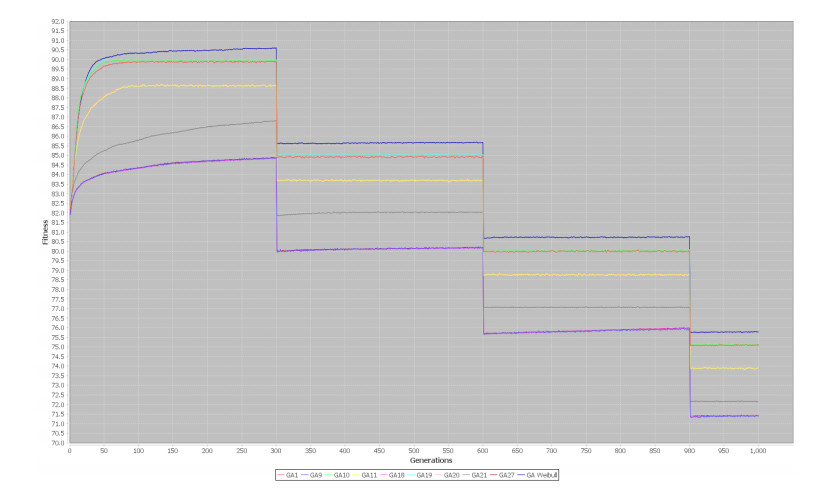In last decades, the interest to solve dynamic combinatorial optimization problems has increased. Metaheuristics have been used to find good solutions in a reasonably low time, and the use of self-adaptive strategies has increased considerably due to these kind of mechanism proved to be a good alternative to improve performance in these algorithms. On this research, the performance of a genetic algorithm is improved through a self-adaptive mechanism to solve dynamic combinatorial problems: 3-SAT, One-Max and TSP, using the genotype-phenotype mapping strategy and probabilistic distributions to define parameters in the algorithm. The mechanism demonstrates the capability to adapt algorithms in dynamic environments.
1.
Introduction
Fractional-order differential equations (FDM) have many applications in various fields of engineering and science, such as chemical and physical phenomena [2,3,4,5]. For instance, the fractional-order diffusion equation is used to describe anomalous diffusion phenomena in the transport process through disordered and complex systems including fractal media, fractional kinetic equations regarding slow diffusion, and movement of small molecular along the concentration space [6].
In this article, the two-dimensional (2-D) time-fractional sub-diffusion equation (FSDE) with the weak singularity at initial time t=0 is considered as follows:
with subject to conditions
and
where ζ0, ζ1, ζ2, ζ3, ζ4 are known functions and α∈(0,1).
The FSDE can be obtained from the anomalous diffusion system by replacing the time derivative with a fractional derivative α where 0<α<1. The FSDE is an important class of fractional partial differential equations (PDEs), which is mainly used in the modeling of fractional random walk, the phenomenon of wave propagation, diffusion unification, etc. [7,8].
The Caputo derivative of order α is
The Caputo derivative approximated using the L1 gives the accuracy 2−α [9,10], but the presence of kernel (t−x)α produces solutions for Eq (1.1) with the weak-singularity at initial time t=0, which increases the computation cost and give low convergence rate for the approximate methods on uniform meshes [11]. Therefore, to increase the convergence rate many researchers solved the FSDE using different high-order numerical methods. Based on the chronology, several numerical methods are proposed for the solution of 2-D time FSDE (1.1), for example, Cui [12] proposed high-order alternating direction implicit (ADI) method, and it is unconditionally stable and convergent with convergence order O(να+h40). Zhuang and Liu [13] proposed an unconditionally stable and convergent implicit difference scheme. Zhang et al. [14] used the Crank-Nicolson-type compact ADI scheme and proved the unconditional stability and convergence having convergence order O(νmin[2−α2,2α]+h014+h024) in H10 norm. Ji and Sun [15] used a high-order numerical scheme to solve (1.1), and proved convergence in L1(L∞)-norm and unconditional stability by the energy method. Wang et al. [16] solved 2-D FSDE using C-N alternating direction implicit finite difference method (FDM), where the fractional derivative is discretized using Riemann-Liouville fractional definition and to improve its temporal accuracy they used the Richardson extrapolation algorithm. Also, they proved its unique solvability, unconditional stability, and convergence O(ν2γ+h0x4+h0y4) of the scheme. Zhai and Feng [17] presented three different compact schemes for a 2-D time-fractional diffusion equation. The Caputo fractional definition is used for fractional derivative. All the schemes are fourth-order accurate for space and second-order accurate for the time variable. The stability of all the schemes is analyzed using Fourier analysis, which shows that two schemes are unconditionally stable, and the third one is conditionally stable.
The advantage of high-order schemes is that it produces more accurate results but at the same time increase the execution timings because of the escalated computational complexity of the scheme. Similarly, the advantage of explicit group methods over the standard point methods that the it considered quarter grid points of the solution domain and the points are considered as iterative points in the iterative process which reduces the computational complexity of the proposed method and hence reduce the execution time per iteration. Since, the computational complexity is greatly reduced using the explicit group method the 2-D time-fractional advection-diffusion, hyperbolic telegraph fractional differential, and fractional diffusion equations etc. [18,19,20,21,22] with second-order accuracy, therefore, we proposed the grouping strategy with uniform grids for the solution of the 2-D time FSDE with fourth-order accuracy. The purpose of this paper is to solve 2-D time FSDE with the fourth-order explicit group method (FEGM).
The paper is organized as follows: In Section 2, the derivation of the group explicit method from the finite difference method is presented. Section 3 discussed the stability of the proposed scheme, and the convergence of the proposed scheme is presented in Section 4. To show the efficiency of the proposed method, some numerical examples with discussion are presented in Section 5, and finally, Section 6 consists of the conclusion.
2.
The fourth-order grouping scheme
First, let us define some notations:
where h0=Δx=Δy=LM represents the space step and ν=TN time step.
Since, the Taylor series expansion with respect to x is
By adding Eqs (2.1) and (2.2) and after rearranging, we get
Therefore, the Taylor series expansions at points uki+1,j and uki,j+1 are
The difference operator δ2x, which maintain the three-point stencil is given by []
and
The fractional derivative is approximated using the Central difference formula as [24]
Therefore, after some simplifications, the Crank-Nicolson (C-N) Caputo fractional derivative
Now using Eqs (2.6)–(2.8) and C-N or standard point (SP) scheme at V(xi,yj,tk+12), the standard fourth-order finite difference scheme for Eq (1.1) is as follows:
Substituting the values of δ2x, δ2y and Vk+12i,j into Eq (2.9), and after rearranging we get the standard point SP compact scheme:
where
Now, using Eq (2.10) will give the following system for the group of four points:
where
and
Similarly, the inverted matrix equation (2.11) will give explicit group equation
where
In the proposed method, firstly, group of four points are computed for the different iterations using Eq (2.12) till the required convergence is attained. After the required convergence, the SP compact scheme Eq (2.10) is used directly once for computing of reaming points. Figures 1 and 2 show the grid points on the x-y plane for FDM and FEGM at various time levels when m=9 respectively.
3.
Stability of the FEGM
In this section, the stability of the proposed method is discussed.
The Eq (2.12) can also be written as
where
It can observe that Eq (3.1) form the particular structure as
Proposition 3.1. The proposed scheme Eq (2.12) is unconditionally stable.
Proof. Let Vki,j represents approximate and vki,j represents exact solutions for the time FSDE respectively, then the error is defined as ϵki,j=vki,j−Vki,j. So, from Eq (3.1),
where
From Eq (3.1) we know
where I and Q are two matrices, I represents identity matrix and Q represents unity values having each diagonal forthwith above and below the main diagonal, and elsewhere zero.
Suppose maximum eigenvalues are represented with ψ, χ and η for the matrices A, B and C respectively, then using Mathematica software, we get
From Eq (3.2), when k = 0,
But since a1=σ((32)1−α−(12)1−α)=g0(31−α−1) and g1=a1−g0=g0(31−α−2). Also we know that 31−α<3, so,
Hence,
Suppose
and for r=k+1,
So, by mathematical induction, we prove that FEGM is unconditionally stable.
4.
Convergence analysis
Suppose ek+12i,j,ek+12i+1,j,ek+12i+1,j+1 and ek+12i,j+1 represent different truncation errors, then,
where
so from Eq (2.10) we have
where φ0 is a constant.
Proposition 4.1. The FEGS equation (2.12) is unconditionally convergent with the order of convergence O(ν2−α+h4).
Proof. Since from Eq (4.1),
then,
Since E0=0, then from Eq (2.10), we have
When k=0,
Assume that
and now from Eq (4.4),
By taking norm function on both sides of Eq (4.6),
where γ=133+121h2g1+1.68h20(ak−a1)348+79h20g0, but since h∈(0,1), g0>g1, and (a1−ak)<0, then γ∈(0,1), therefore,
Therefore, we get
Thus the proposed scheme is conditionally stable.
5.
Solvability of the proposed scheme
The proposed scheme can be written in matrix form:
where
Proposition 5.1. The difference equation (2.12) is uniquely solvable.
Proof. Since λ1=172(240+100h20g0), λ2=172(48−10h20g0), λ3=172(12−h20g0), and h0,g0>0, then,
and
Hence, |λ1|>3|λ2|+2|λ1|, which shows that matrix G1 is strictly diagonally dominant and G1 is non-singular. This completes the proof.
6.
Numerical experiments and discussion
The proposed method is simulated using the Intel Core i-7, 2.40GHz GHz, 6GB of RAM with Windows 8 using Mathematica software, and the experiments were done using the proposed method with SOR iterative technique as an acceleration factor (ω=1.8) with different mesh sizes (n=10,14,18,22,30) and different time steps. Furthermore, throughout the experiments, the L∞-norm convergence criteria ζ=10−5 is used. Also, the C2-order and C1-order of convergence are used for the computational order of spatial and temporal convergence using [25]
where L∞ is the maximum error.
Some examples are presented below to show the efficiency of FEGM.
Problem 1. [26]
with initial and Dirichlet boundary conditions.
The analytic solution for Problem 1 is
Problem 2. [12]
with initial and Dirichlet boundary conditions.
The analytic solution for Problem 2 is
The number of iterations, error analysis, and execution times are shown for the comparison between FEGM and SP methods from Tables 1–5. The execution times in FEGM are decreased by (4.7−28.49)%, (2−23)%, (9.16−28.13)%, (8.9−25.39)% and (6.98−27.79)% compared to SP method in Tables 1–5 respectively. Similarly, in Table 6, the comparison between the proposed method and high-order standard point method[27] is presented, which shows the proposed method gives better results. Figures 3 and 4 represent the exact and approximate solution for Problem 1, respectively, which depicts the effectiveness of the FEGM. Likewise, In Figure 5, the compression of execution times between the SP and proposed methods are shown, which shows the proposed method is efficient in terms of execution timings. Table 7 shows the computational complexity per iteration, while the computational effort is shown in Tables 8 and 9, which depict that the FEGM requires less number of operations during computations as compared to the standard SP method. Tables 10 and 11 represent the spatial convergence order for Problems 1 and 2, respectively. Similarly, Tables 12 and 13 represent the temporal convergence order for the first and second Problem respectively, which depict the experimental and theoretical convergence orders in agreement.
7.
Conclusions
In this article, the 2-D fractional sub-diffusion equation is solved using the fractional explicit group method with weak singularity at initial time t=0, where the standard point finite difference scheme is used for the development of the fourth-order grouping scheme. The fractional explicit group method reduces the computational complexity and execution time by comparing it with the standard point fourth-order method without deteriorating the accuracy of the solutions. Furthermore, the unconditional stability and convergence of the proposed scheme are proved using the matrix analysis via mathematical induction, which confirms the feasibility and reliability of the new formulation.
Acknowledgments
This work was supported by the Ministry of Higher Education under Fundamental Research Grant Scheme (FRGS/1/2019/STG06/UTM/02/13, FRGS/1/2020/STG05/UTM/02/12).
Conflict of interest
We declare no conflicts of interest in this paper.
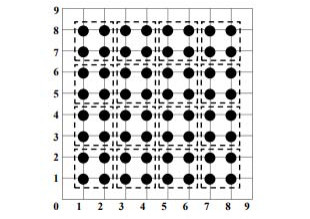









 DownLoad:
DownLoad:





